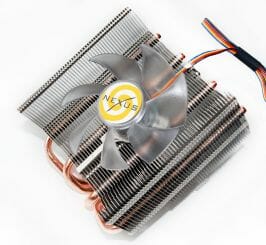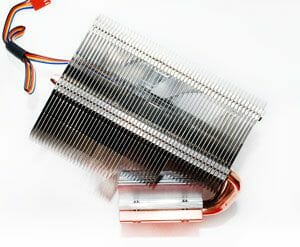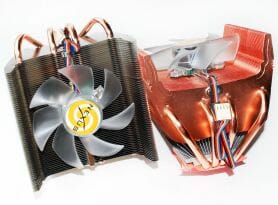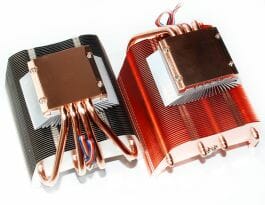New CPU Coolers from Nexus: FLC-3000, XiR-2300 and XiR-3500

We have already introduced fans from Nexus to you in our latest fan roundup. Today we are going to talk about complete cooling solutions from this company.
Our regular readers should be already familiar with the solutions from the Dutch Nexus Company, because we have already introduced their cooling fans in our article called Be Cool: Ultimate 120/140 mm Fans Roundup. It turned out that in an effort to promote the quiet PC concept Nexus offers not only fans, but also complete processor coolers. In our opinion the cooling solutions of the same type including FLC-3000, XiR-2300 and XiR-3500 models are currently the most interesting in the company’s product range. So our today’s review will be focusing on them.
We can’t say that they are brand new at this moment, because they were launched under Nexus brand name in the end of 2008 and started selling in early 2009. Moreover, CoolJag Company has been manufacturing these particular models since 2007, although they were called differently back then: Falcon 92-Al and Falcon 92-Cu. However, Nexus doesn’t try to conceal the fact that their coolers are made by CoolJag, as there is corresponding mention on the cooler packaging and in the instruction manuals. Nexus only adds their branded fans to the coolers (although they are also originally made by Everflow). So, we are going to talk about these combination cooling solutions today in a little more detail (the coolers were provided to us by EndPCNoise.com online store).
Packaging and Accessories
All coolers are packed in similarly shaped cardboard boxes with plastic carry handles. All of them have a cut-out window in the front, which allows you to see part of the cooler inside.
Inside the cardboard box there is a clear plastic blister with the cooler sealed inside. There is a small flat box with accessories next to it.
All three coolers come with the same accessories bundles. They are all made in China and feature three-year warranty. The coolers are pretty expensive: the recommended price for the Nexus FLC-3000 is $55, for Nexus XiR-2300 and XiR-3500 – $60 and $70 respectively.
Nexus FLC-3000
All three coolers look very similar, because they all use similar design. Nexus FLC-3000 model stands out the most that is why we are going to start with it.
Design and Functionality

The cooler is built on four copper heatpipes each 6 mm in diameter that are soldered to the copper base. There is an additional aluminum heatsink right above the base. The heatpipes hold an array of aluminum plates topped with a 92 mm fan. Below is the schematic of Nexus FLC-3000 cooler.
The cooler measures 128 x 105 x 119 mm and weighs 450 g. The peculiarity of FLC-3000 is that its heatsink is at a 30° angle to the base:

This way it is fairly hard to determine the type of this cooler: tower or top. This is what makes FLC-3000 similar to the Katana coolers from the Japanese Scythe Company, which heatsinks are also positioned at an angle to ensure better cooling of the heatsinks over the voltage regulator components on the board.
Overall, Nexus FLC-3000 heatsink array consists of 52 aluminum plates of three types, each being 0.40-0.45 mm thick. They are spaced out at 2 mm from one another. The array has a cup-shape, so the fan appears sitting inside the heatsink.
The heatpipes are positioned almost linearly inside the heatsink. The distance between all of them is the same.Note that all heatpipes pass very close to the top edge of the heatsink plates that is why we are in fact concerned about proper cooling of the third largest part of the heatsink array.
There are special grooves curt out in the cooler base for the heatpipes, which increases the contact surface between the heatpipes and the base and improved heat transfer.
The heatpipes are soldered to the base. The thinnest part of the copper base plate below the heatpipes is 2 mm. we didn’t notice any traces of thermal interface of any kind between the heatpipes and a small aluminum heatsink installed right above them.
The finish quality of the base surface is totally ideal.Unfortunately, we can’t say the same about its evenness.
Even with a naked eye you can see a deepening, although it was ideally even over the entire contact surface with an LGA775 processor, as you can see from the thermal compound imprints below.
However, with an LGA1366 (or Socket AM2) processor, which features larger hear-spreader, the cooler was simply hanging on the sides of the CPU heat-spreader and there was no contact of any kind at all. At this point I can point out that we discovered this frustrating defect on all three Nexus coolers that we received for review. The cooler base plate measures 43×47 mm.
As I have already mentioned, Nexus FLC-3000 is equipped with a frameless 92 mm fan, which measures 84 mm in diameter. Seven semi-transparent fan blades have very aggressive curve and wider outer side.
The rotation speed of this fan originally made by Everflow (T128025DM AF model) is controlled using pulse-width modulation (PWM) method in the interval from 900 to 2500 RPM (±10%). The claimed level of noise is 15-24 dBA. There is no mention of the airflow and static pressure. The fan uses a slide bearing and can consume up to 1.7 W of power under peak load.
We don’t know how long the bearing is supposed to last, as the MTBF is not specified. The fan comes with a 300 mm cable.
Compatibility and Installation Tips
Now let’s get to the compatibility and installation of Nexus FLC-3000 cooler. In its default configuration this solution is compatible with all contemporary platforms except LGA 1156. However, the official web-page devoted to this cooler indicates that the corresponding retention is already available from Nexus that is why everything you have to do to get it (if you already have this cooler) is to write an email with the retention kit request to the company. It is very nice to see that not only Noctua takes such good care of their users.
The cooler installation procedure is described step-by-step in the manual (PDF-file, 3.13 MB). The entire process is fairly simple. You have to mount the appropriate retention kit to the base of the cooler.
And then tighten the retention screws through the PCB using a backplate or plastic washers (for LGA1366). In both cases you will need to remove the mainboard from the system case. However, in case of an AMD platform, Nexus FLC-3000 installs way simpler, because in this case the cooler retention will catch on to the plastic loops in the default retention frame around the CPU socket, which is already pre-installed. After that you just have to tighten the screws.
It is very convenient that the installation instructions contain all the dimensions, which will help the user to determine if Nexus FLC-3000 will fit into the system case and onto the mainboard or not.
I have to say that this cooler was very friendly to all the heatsinks surrounding the processor socket, including the mainboard chipset heatsink. However, there is no mention of the preferred cooler positioning anywhere in the manual that is why we installed to ensure the most effective heat transfer and cooling, namely, with the heatpipe ends facing up.
Nexus XiR-2300 and Nexus XiR-3500
Design and Functionality
At first glance, Nexus XiR-2300 and XiR-3500 coolers seem pretty similar to FLC-3000, but despite this external similarity, there are still quite a few differences:


First of all, the heatsink is not at an angle anymore: it is placed parallel to the cooler base. The scheme of the cooler layout looks as follows.
Both solutions are of the same size – 106x122x111 mm. the only difference between XiR-2300 and XiR-3500 is the material used for the heatsink plates: the first one is made of aluminum, while the second one – of pure copper. As a result, the first cooler weighs 382 g and the second – 736 g.
Both coolers, just like the FLC-3000, use four copper heatpipes , each 6 mm in diameter, that are soldered to the copper base. The heatsink plates are pressed against the heatpipes tightly and topped with a frameless 92 mm fan.
The plates in these two coolers are thinner than those of the FLC-3000: only 2.0-2.25 mm, but there are more of them in the array: 65 plates in each.
The gaps between the heatsink plates are almost the same as by FLC-3000 (1.8-2.0 mm). However, the heatpipes are laid out differently inside the heatsink: two heatpipes in the middle are closer to one another than those in the FLC-3000 cooler.
In my opinion, this close placement of the central heatpipes lowers the cooler efficiency, because the heat will not be distributed evenly over the heatsink plates. Moreover, the heatpipes fall into what’s called the “fan dead zone”.
By the way, although the fans of XiR-2300 and XiR-3500 coolers are of exactly the same design as the fan of the FLC-300, which we have just discussed, they have different mechanics.
Besides different electrical specifications, Everflow T128025BUTC fans are equipped with thermal diodes, which allow the fan rotation speed to vary in the interval from 1200 to 2500 RPM (±10%). However, the claimed noise level is the same: 15-24 dBA.
Compatibility and Installation Tips
These two coolers are installed exactly the same way as Nexus FLC-3000, although they have stricter requirements regarding the available free space in the area around the CPU socket.
Since the distance from the cooler central axis to the ends of the curved heatpipes is 67 mm, XiR-2300 and XiR-3500 can only be installed one way onto our DFI LANPARTY DK X48-T2RS mainboard with an LGA775 socket: with the heatpipe ends turned towards the back of the system case. There were no compatibility issues of any kind on Asus P6T Deluxe (LGA1366), as it has more freedom around the CPU socket, so you can install these coolers any way you want. You can download the installation instructions from the official company web-site (PDF file, 1.74 MB).
Testbed and Methods
Since the base surface of the discussed coolers is extremely uneven, we couldn’t use them with Core i7 and Phenom II X4 processors. Therefore, we performed the tests with Intel Core 2 Extreme QX9650 processor. So the testbed we used this time featured the following components and configuration:
- Mainboard: DFI LANPARTY DK X48-T2RS (Intel X48), LGA 775, BIOS 10/03/2008;
- Processor: Intel Core 2 Extreme QX9650, 3.0 GHz, 1.15 V, L2 2 x 6 MB, 333 MHz x 4 FSB, (Yorkfield, C0);
- Thermal interface: Tuniq TX-2;
- Graphics card: ZOTAC GeForce GTX 260 AMP2! Edition 896 MB, 648/1404/2108 MHz (1030 RPM);
- Memory:
- 1 x 1024 MB Corsair Dominator TWIN2X2048-9136C5D (Spec: 1142 MHz / 5-5-5-18 / 2.1 V);
- 2 x 1024 MB CSX DIABLO CSXO-XAC-1200-2GB-KIT (Spec: 1200 MHz / 5-5-5-16 / 2.4 ВV);
- System HDD: Western Digital Caviar Black WD6401AALS;
- System case: Thermaltake Strike MX (VI6001BNS) (air intake: Noctua NF-P12 fan on the front panel at 1000 RPM (behind the dust filter), air exhaust: Noiseblocker NB-BlackSilent XL1 fan at 1020 RPM), case side panel removed;
- Control and monitoring panel: Zalman ZM-MFC3;
- Power supply: Thermaltake Toughpower XT 850 W.
During this test session we managed to overclock our 45nm quad-core processor (with polished heat-spreader) with the multiplier set at 10x only to 3.63 GHz using the weakest cooling system of the today’s testing participants. The nominal processor Vcore was increased to 1.45 V in the mainboard BIOS.
All tests were performed under Windows 7 RTM x64 operating system. We used the following software during our test session:
- Real Temp 3.38b – to monitor the processor core temperature;
- Linpack 64-bit with LinX shell version 0.6.4 – to create maximum CPU load (two test cycles, 5 Linpack runs in each cycle with 3072 MB RAM capacity involved);
- RivaTuner 2.24 – for visual control over temperature changes (with RTCore plagin);
- Everest 5.02.1925b – to monitor fans rotation speeds;
- CPU-Z 1.52.2 – to monitor processor core voltage and frequency.
The CPU was loaded with two consecutive Linpack test runs with the settings as indicated above. The stabilization period for the CPU temperature between the two test cycles was about 8-10 minutes. We took the maximum temperature of the hottest processor core of the four for the results charts. The ambient temperature was checked next to the system case with an electronic thermometer with 0.1 °C precision that allows monitoring the temperature changes over the past 6 hours. During our test session room temperature was at 23.8-24.2 °C.
For the sake of more illustrative comparison we are going to add the best top-cooler – XILENCE Black Hawk COPPER – to compete against Nexus solutions in our today’s test session.
We tested this cooler in two test modes: in very quiet mode at 900 RPM and during automatic fan rotation speed control using PWM method in the interval from 710 to 1800 RPM.
Cooling Efficiency Tests
The first thing that catches your eye is the fact that the junior and the least expensive Nexus FLC-3000 turned out much more efficient than two higher-end models: XiR-2300 and XiR-3500. It won 12°C from the aluminum model and the whole 10°C from the copper one. Here it is, however, important to check the rotation speeds of the cooler fans, because the FLC-3000 fan is honestly PWM controlled in the entire range, while the fans of the XiR models work at 1240-1760 RPM maximum! In other words, the thermal diode installed incorrectly doesn’t really do its job right. Things didn’t get any better even after I bent the diode a little towards the bottom, so that it could be as close as possible to the hot heatsink plates: it still didn’t speed the fans up to their maximum.
However, if you look at the results of the XiR-3500 cooler with the FLC-3000 fan (the fourth results from the top on the diagram), you will notice that a faster fan helped the copper cooler improve its efficiency by 4°C compared with the results obtained with the cooler’s default fan. It means that XiR models owe their unimpressive performance compared with FLC-3000 is not only to the fans and thermal diodes, but also to a few other factors. Among them could be not the best cooler positioning (I have to remind you that we tested the XiR coolers in the only possible position: with the heatpipes ends turned towards the back of the system case, while FLC-3000 was installed with the heatpipe ends facing up). I also can’t exclude the effect of the uneven base plate: we can’t guarantee proper contact between the cooler base and the CPU heat-spreader even though the thermal compound imprints were good enough.
As for the comparison between Nexus coolers and XILENCE Black Hawk COPPER, the best top-cooler boasts an indisputable advantage over the competitors. Even in quiet mode it proved 4°C more efficient than the best Nexus offering at its maximum fan speed. And in the PWM controlled mode Black Hawk adds another 4°C to its advantage.
In addition to the previous test we also checked the maximum CPU frequency with the best Nexus cooler – FLC-3000 and compared the results against XILENCE Black Hawk COPPER at this frequency. Here is what we got.
In fact, the 3.76 GHz frequency at 1.525 V Vcore we managed to hit with Nexus FLC-3000 are a pretty good result. But XILENCE Black Hawk COPPER cools the CPU 11°C better in the same testing conditions. So, there is nothing else we can really say at this point.
Unlike the efficiency of the Nexus solutions, their acoustic performance is really remarkable. The fans work noiselessly in the interval from 900 to 1300 RPM, very quietly up to 1800 RPM and with moderate noise up to the maximum rotation speed of 2600 RPM. Like the 120 mm Nexus Basic case fans, Nexus coolers boast very low overall noise threshold that is why they will suit perfectly for HTPC systems (provided they fit in fine), because systems like that are very sensitive to noise and do not require super efficient cooling.
Conclusion
Unfortunately, Nexus coolers tested today didn’t do too well: these are not very efficient but expensive coolers. And if we could somehow justify the price of the least expensive solution, Nexus FLC-3000, (although there are much more options available in the $50 price range these days), then XiR-2300 and XiR-3500 do not stand any criticism. Very expensive coolers with limited compatibility with existing mainboards featuring very uneven base surfaces – all this didn’t let them compete successfully even against their junior fellow, not to mention a super-cooler. The fans also contributed to an overall sad picture, because their thermal diode was installed in a spot where it would never be able to precisely monitor the heatsink/processor temperature and hence adjust the fan rotation speed in a timely manner.
As for the definite advantages of the Nexus cooling solutions reviewed today, we should point out support of all contemporary platforms, including LGA1156 (you have to email the manufacturer to receive your free retention kit), attractive looks, fan LEDs and most importantly – low noise. Excellent acoustics is probably the only significant argument in favor of a Nexus solution. And it is a real pity that not enough attention has been paid to all other aspects of a cooler success, including adequate price point.
We would like to thank EndPCNoise.com online store for providing us these coolers for review.